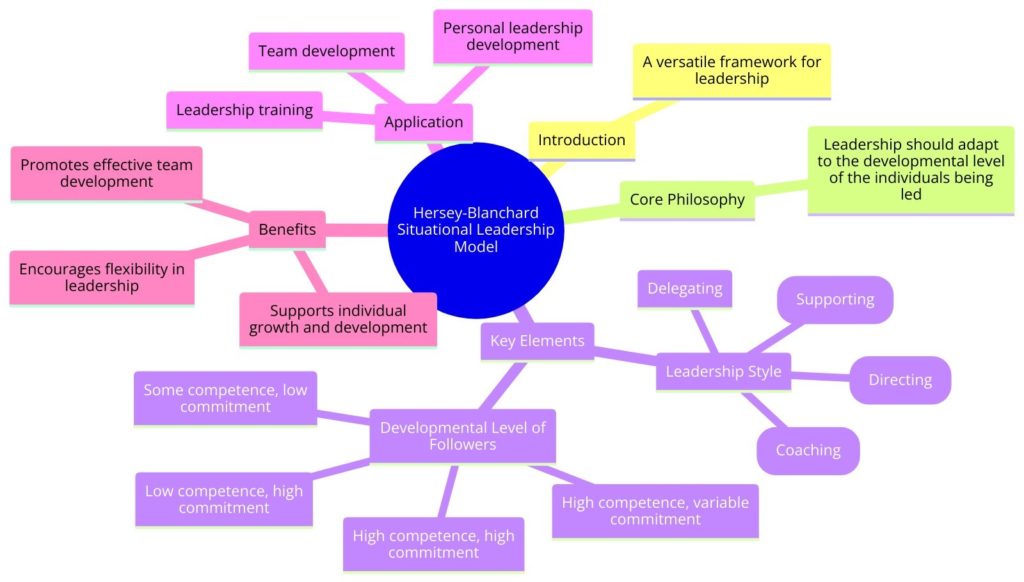Situational Leadership Model
Hersey-Blanchard’s Situational Leadership Model is a versatile framework that addresses leadership from a situational perspective, emphasizing the importance of adapting leadership style to the developmental level of the individuals being led. Developed in the late 1960s by Paul Hersey and Ken Blanchard, the model outlines how leaders can be most effective by being flexible and choosing the right style of leadership for the situation at hand based on the maturity level of their followers.
What is Hersey-Blanchard’s Situational Leadership Model?
The model identifies four main leadership styles, each appropriate for different levels of follower maturity and readiness:
- Telling (S1): A high-task, low-relationship style where the leader defines roles and tells people what, how, when, and where to do various tasks. This style is best suited for followers with low maturity (M1) who lack the specific skills required for the job and are unwilling or too insecure to take responsibility.
- Selling (S2): A high-task, high-relationship style where the leader still provides direction but also uses two-way communication and provides the socio-emotional support that followers might need. It’s best for followers with low to moderate maturity (M2) who are unable to take responsibility but are willing or motivated to work.
- Participating (S3): A low-task, high-relationship style emphasizing shared ideas and participative decision-making. It’s suited for followers with moderate to high maturity (M3) who have the skills to perform the job but lack the confidence to take on responsibility.
- Delegating (S4): A low-task, low-relationship style where the leader delegates decision-making responsibility and does not provide significant direction. This style is best for followers with high maturity (M4) who have the skills and willingness to take on responsibility for their task or project.
Why It Is Valuable
Hersey-Blanchard’s Situational Leadership Model is valuable for multiple reasons:
- Flexibility: It emphasizes the importance of adapting leadership style according to the follower’s readiness, promoting flexibility in leadership approaches.
- Enhanced Effectiveness: By aligning leadership style with follower maturity, leaders can enhance their effectiveness, improving team performance and individual development.
- Improved Communication: The model fosters open communication between leaders and followers, helping to clarify expectations and provide the needed support.
- Developmental Focus: It encourages the development of followers by progressively moving them towards higher levels of maturity and autonomy.
When and How to Use It
The Situational Leadership Model can be effectively used in various contexts, including team management, coaching, personal development, and organizational change. To use the model:
- Assess the maturity level of followers by considering their ability and willingness to perform a specific task.
- Determine the most appropriate leadership style based on the maturity assessment.
- Apply the identified leadership style, being prepared to adjust as the maturity level of followers changes over time.
- Regularly reevaluate the development level of followers and adapt leadership style as necessary.
Shortcomings/Criticisms
Despite its popularity and practical application, Hersey-Blanchard’s Situational Leadership Model has faced several criticisms:
- Over-Simplification: Critics argue that the model oversimplifies the complex nature of leadership by reducing it to only two dimensions and four styles.
- Lack of Empirical Evidence: Some studies have questioned the empirical support for the model, suggesting that its effectiveness may not be as universal as proposed.
- Ambiguity in Maturity Assessment: The model’s criteria for assessing maturity levels can be ambiguous, making it challenging for leaders to accurately determine follower readiness.
- Cultural Limitations: The model may not account for cultural differences that can influence leadership effectiveness and follower perception.
The Hersey-Blanchard’s Situational Leadership Model provides a useful framework for understanding how leadership style can be adapted to meet the needs of followers based on their maturity level. While it offers valuable insights into flexible leadership and follower development, leaders should be mindful of its limitations and consider it as one of several tools in their leadership toolkit, complemented by other theories and practices for a more holistic approach to leadership.


